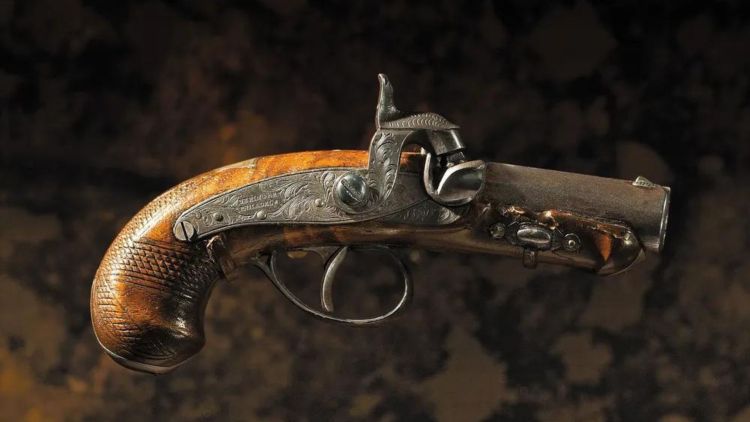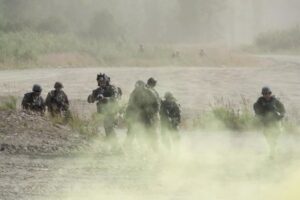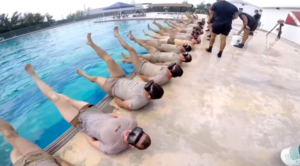The Weapon: A Deringer Pistol
John Wilkes Booth chose a .44 caliber Deringer pistol to assassinate President Abraham Lincoln. The Deringer was a popular firearm in the mid-19th century. This was particularly used by individuals who needed a weapon that was both easily concealable and reliable.
More About the Deringer
Unlike the revolvers commonly used during that period, the Deringer was a single-shot pistol, meaning it could only fire one round before needing to be reloaded.
The pistol Booth used was manufactured by Henry Deringer, a well-known gunmaker based in Philadelphia. Deringer’s pistols were highly regarded for their craftsmanship and reliability.
The term “Derringer” (with an extra “r”) became generic for any small-sized handgun, though the original was spelled with a single “r,” following the manufacturer’s name. The Deringer used by Booth was compact, measuring just six inches in length, with a wooden stock and a short barrel that made it easily concealable.
The lead bullet had the mass and velocity to penetrate deeply, especially when fired at close range. This caliber, larger than what most pocket pistols would use, made the weapon particularly lethal at close range.
The Assassination: A Cruel and Calculated Act
The assassination took place at Ford’s Theatre in Washington, D.C., during a performance of Our American Cousin. President Lincoln was attending the play with his wife, Mary Todd Lincoln, and two guests, Major Henry Rathbone and his fiancée, Clara Harris. Booth, a well-known actor, had easy access to the theater and knew the layout well, allowing him to plan his attack with precision.
The Deringer wielded by John Wilkes Booth measured approximately 6 inches in length, with a 2.5-inch barrel. Its walnut stock was finely checkered for improved grip. (Wikimedia Commons)
Booth waited until a moment in the play when he knew the audience would be laughing loudly. He hoped the sound of the laughter would mask the noise of the gunshot.
As the crowd erupted in laughter during one of the play’s comedic lines, Booth made his move. He entered the Presidential Box quietly, unnoticed by those inside. Then, at point-blank range, he aimed his Deringer at the back of Lincoln’s head and pulled the trigger.
The bullet entered Lincoln’s skull just behind his left ear, traveled through his brain, and lodged near the front of his skull. The impact was immediate and devastating.
Lincoln slumped forward in his chair, unconscious and critically wounded. Major Rathbone, reacting to the shot, attempted to apprehend Booth, but Booth managed to stab Rathbone with a knife and then leaped onto the stage below, shouting “Sic semper tyrannis!”—”Thus always to tyrants” — as he made his escape.
The Weapon’s Recovery and Evidence
In the chaos that followed the assassination, Booth managed to flee the theater, but his weapon was left behind. The Deringer pistol was found on the floor of the Presidential Box, a grim reminder of the violence that had just occurred. Investigators quickly identified the pistol as the murder weapon, and it became a crucial piece of evidence in the manhunt for Booth.
The Deringer had no serial number, which was not uncommon for firearms of that era. However, the gun’s distinctive design and Booth’s own belongings, including the holster found at his boarding house, helped to confirm its ownership. Witnesses who had seen Booth at the theater before the assassination also helped to link him to the weapon.
Booth’s escape triggered one of the largest manhunts in American history, and the evidence left behind, including the Deringer, provided authorities with critical leads. After 12 days on the run, Booth was cornered and killed by Union soldiers in a barn in Virginia.
The Aftermath: A Nation in Mourning
The assassination of Abraham Lincoln sent shockwaves across the nation. He was the first U.S. president to be assassinated, and his death came just days after the end of the Civil War, a conflict that had already claimed the lives of hundreds of thousands of Americans.
Following the assassination, the gun was recovered from Ford’s Theatre and became a crucial piece of evidence. Today, this notorious pistol is exhibited at Ford’s Theatre National Historic Site, standing as a poignant reminder of the tragic event. (Rock Island Auction)
Lincoln had been a unifying figure, guiding the nation through its darkest hours. And his death left the country in a state of deep mourning and uncertainty.
The Deringer pistol, now a symbol of that tragedy, was kept by the War Department. It was also used as evidence in the trials of Booth’s co-conspirators.
These trials led to the execution of four of Booth’s accomplices and the imprisonment of several others. The pistol was later placed on display at Ford’s Theatre, where it remains today. It serves as a powerful reminder of the fragility of life and the impact of violence on history.
The Legacy of Lincoln’s Assassination
The assassination of Abraham Lincoln had far-reaching consequences. It plunged the nation into a period of deep grief and left a void in the leadership that was desperately needed during the Reconstruction era.
The Deringer pistol used by Booth has become an iconic artifact, frequently featured in historical discussions and various media. (History.com)
Lincoln’s death altered the course of American history, affecting everything from the process of reunifying the country to the treatment of the Southern states.
In terms of security, the assassination of Abraham Lincoln exposed significant vulnerabilities in how the President was protected. The ease with which Booth was able to carry out his attack highlighted the need for better security measures, leading to the eventual creation of a dedicated Secret Service tasked with protecting the president and other high-profile officials.
The Deringer Pistol in Historical Context
The Deringer pistol Booth used has since become an iconic artifact, often discussed in historical analyses and portrayed in various media.
Its small size and simplicity stand in stark contrast to the monumental impact of the event it was involved in. The gun itself is a product of its time. It reflects the craftsmanship and technological limitations of mid-19th-century firearms.
Henry Deringer’s design was initially intended for personal protection, a common need in the turbulent times of the 1800s. The gun’s popularity stemmed from its convenience as a pocket pistol. Making it a choice weapon for those needing something easily concealed. Booth’s use of the Deringer, however, forever linked the gun to one of the most notorious crimes in American history.
The Gun That Changed a Nation
The Deringer pistol used by John Wilkes Booth on April 14, 1865, was more than just a weapon. It was the instrument of an event that changed the course of American history. With a single shot, Booth not only ended the life of one of the nation’s greatest presidents. But also set the stage for a period of profound uncertainty and transformation.
Today, the pistol remains on display at Ford’s Theatre, where it serves as a tangible connection to the past. Visitors to the theater can view the gun that played a pivotal role in American history. It stands as a stark reminder of the consequences of violence and the enduring impact that a single act can have on the course of a nation.
The story of Lincoln’s assassination and the Deringer pistol that made it possible continues to resonate. This reminds us of the fragility of leadership and the importance of preserving the values that Abraham Lincoln dedicated his life to defending.



